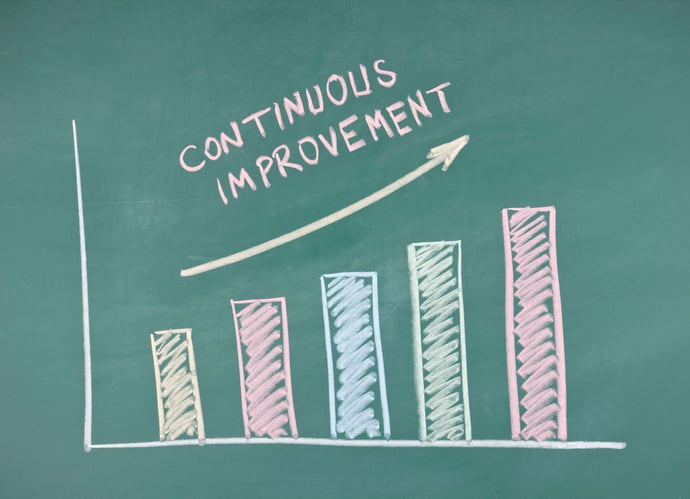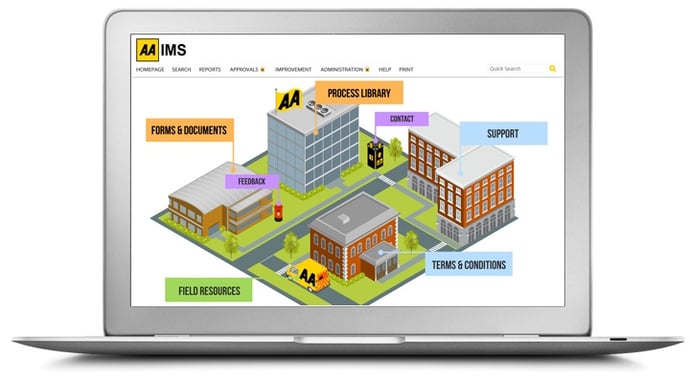Continuous Improvement is the repeated modification of the ‘way we do things’, each modification moving the organisation closer to its improvement goals (whatever these may be).
The essence of Continuous Improvement is that it is an on-going, every-day, permanent part of the organisation’s focus; therefore the individual modifications tend to be relatively small in risk and benefit. But add a lot of them up over time and they make a difference. This is contrasted with ‘big hit’ re-engineering approaches to improvement where a complete end-to-end process re-design leads to organisational or even whole supply chain transformations; these are much less frequent, much higher impact and of course much greater risk.

Where Can Continuous Improvement go Wrong?
With Continuous Improvement, because the modifications tend to be relatively small and low risk, there also tends to be a more distributed, devolved decision-making structure in respect of authorising change. Rather than sitting centrally with a single change team, Continuous Improvement encourages team and departmental level discussions of change, and in most businesses authority to change is devolved to a Process Owner.
So, in a world of Continuous Improvement there is a lot of change taking place. And although each change is relatively small in nature, and low risk, the sheer amount of change and the need to focus constantly on how to do things better is itself a major risk. It can affect morale, it can move focus off urgent and important present day problems and it can unbalance a team. In an ideal world Continuous Improvement would happen as an organisational need to constantly improve no matter how well it is currently performing. Unfortunately though, most Continuous Improvement happens in response to poor performance, so things are already tough.
Poor performance and lots of change as a consequence - add it all up, and you potentially have a lot of problems on your hands. Passive resistance to change becomes active hostility. Cynicism creeps in. Before you know where you are, the perfectly rational, laudable and indeed commercially necessary drive to continuously improve the organisation’s performance becomes the very thing that damages it the most. In this situation, staff will often believe poor organisational performance is a consequence of change, rather than the absence of it. It is almost impossible to pull that situation round and gain positive support for Continuous Improvement approaches without changing the team.
Reduce Continuous Improvement Risk With BPM
Given change is a good thing when it moves the organisation closer to its goals, and Continuous Improvement is simply the repeated execution of change to achieve this on an on-going basis, it makes a whole load of sense to do it. However, given that in the attempt to do this there is a risk of going in the opposite direction and further damaging performance, one needs to step very carefully. One needs to actively seek ways to gain most advantage from Continuous Improvement while at the same time minimising all the risks.
To do this requires many things, some of which are:
- Clarity on the improvement goals
- Clarity on the current state – the ‘as-is’ or ‘the way we do things today’
- Clarity on the proposed future state – the ‘to-be’ or ‘the way we will do things in future’
- Clarity on the delivered benefits and continuous communication to staff of the benefits of the Continuous Improvement programme
- Continuous development of the team’s skills in respect of change implementation
- and many, many more
If everything is clear, and everything is communicated, then the risks reduce massively. The risks don’t disappear, but they are reduced.
And this is perhaps the main way in which a Business Process Management System will enable you to achieve Continuous Improvement.
BPM helps you establish clarity on why change is necessary, what change will take place, who it will affect and what benefit it will generate.

BPM Can Support Continuous Improvement in Several Ways
There are other ways in which BPM can help, some of which are listed below:
- Change approval workflows – this ensures before change is implemented, it has been properly approved
- Measurement techniques embedded in the BPMS will support objective decision making
- Embedded change methods are often included in a BPM platform so there is good tools-based support for change
- Change simulation can frequently be achieved in a BPMS so change can be tested before it is implemented
- BPM offers a re-usable repository that, provided it is maintained, will always be an accurate kick-off point for understanding the current state. Contrast this with the need to re-discover the ‘as-is’ every time change is required.
Climbing Everest in a swimming costume
In conclusion to this article: How to avoid problems with Continuous Improvement by taking a Business Process Management (BPM) approach, I’d like to ask: Can Continuous Improvement be achieved without a BPM System?
In a small company or team, perhaps you can. But in most organisations attempting Continuous Improvement without a BPM system in support would be like attempting to climb Everest in a swimming costume; not impossible I guess, but why would you?
Related articles:
3 Reasons why Continuous Improvement Projects Fail
Continuous Improvement: How do I create a culture of continuous improvement?
How can I get employees engaged enough to propose improvement opportunities?
Written by Michael Cousins
Mike founded Triaster in 1994. A thought leader in business improvement, he has led Triaster ever since, spearheading its development of beautifully engineered business improvement software, that is both full of the functionality required by business analysts and that end users find really easy to use.

